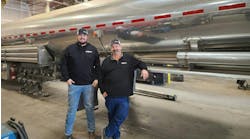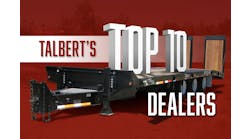Les Smith is convinced he can build a better trailer, and he makes no secret about how he’s going to do it. Indeed, spend a morning with him at the Extreme Trailers LLC facility and you’ll quickly learn the mantra: tare weight, tare weight, tare weight.
Simply, lighter is better, and the industry veteran is betting his late-career startup that improved designs and processes will turn a formerly shuttered trailer manufacturing facility into a hub of innovation that rolls out industry-leading, premium lightweight products.
Smith, Extreme Trailers’ President and CEO, has been in the industry for more than 30 years, with experience in the full range of markets: dump trailers, refuse, drop decks, flatbeds, multi-axle flatbeds, dry box. Don Hayes, vice president of operations, has another 35 years in transportation, including experience at Hendrickson and Freightliner.
“With the number of years we’ve both had in the industry, at very high positions, we were looking for a situation where you can work on your own ideas and your own dreams,” Smith told Trailer-Body Builders during a plant tour in May.
And that dream found a home in an industrial zone in Dover, Ohio, about 80 miles south of Cleveland on I-77, and about mid-way between Columbus and Pittsburgh. The 100,000 sq. ft. facility, a former Tremcar plant, is part of a 10-year agreement with the local Economic Development and Finance Alliance, and includes room for expansion.
“I was vice president of operations, and during the oil-and-gas bust Tremcar chose to vacate. I worked with EDFA and Tremcar to acquire the facility and some machinery and equipment—a plasma table, shear, overhead cranes—so we could open it back up,” Smith said. “The workforce was already here in place that had Tremcar experience building trailers, and also had a tremendous amount of experience in aluminum welding. It’s a very attractive situation when the plant’s already set up to run transportation equipment and product, along with a trained workforce.”
After taking possession of the facility in mid-2016, the new company spent about six months setting up “the infrastructure”—the design technology and tools as well as the production systems. To reduce startup costs, the Extreme team laid out the production line. The first trailers rolled off the line in January.
The facility is set up to handle a capacity of “several thousand” trailers a year. “The most efficient way to lay a plant out is to bring your raw materials in on one end take the finished product out the other end—and that’s exactly what we have today,” Smith said.
As for first-year glitches, the only major issue has been delays in receiving materials, which can stall production—and make Smith a little testy.
“Some of our suppliers have failed in being able to accomplish what they’ve promised us,” Smith said. “We’re a startup, so maybe we’re not a top priority—we’ve certainly seen that in the industry.”
Otherwise, the line is moving well.
“We knew that with our new assembly processes, from Day 1 we’d have to train individuals on every single work center,” Smith said. “If you look at the overall time it takes the build a unit today, we currently have a dozen people producing a trailer a day, which is very efficient. Through the training process, we’ve reduced our overall labor by 100 percent.”
Also on the “diverse” team at Extreme Trailers, Vice-President of Operations Ryan Rummell, director of engineering, comes from the truck side, and was mixer project manager at Kimble Manufacturing. Materials Manager Shawn Ellwood also comes from Tremcar.
“It’s enabled us to know the market, see what’s available, and looks at ways we can be innovative and offer a better product,” Smith said.
Lightweighting techniques
Among Extreme’s key innovations are a patented decking system, a component marketed as CRT (for Crush-Resistant Technology) that is designed to increase carrying capacity while also reducing weight, and proprietary internal frame crossmembers.
As for the decking, the design has taken out several hundred pounds while also being 35 to 50 percent stronger, Smith explained. The patent-pending crush-resistant technology of the decking consists, essentially, of a honeycomb of hollow aluminum tubes into which rods in the shape of three-pointed star fit to provide extra support where needed. For each 10 pounds of additional weight over a six-foot area, there’s a 50 percent increase in strength.
The patented crossmember design enables direct mounting of components such as the suspension and landing gear—again, taking out tare weight by reducing the amount of hardware typically found on flatbed trailers.
Again, through industry experience, the Extreme team identified weight savings to be had by rethinking traditional trailer manufacturing processes.
"We looked at how the product was produced in the plant, and we have eliminated unnecessary features. These are things that are simply on there for manufacturing needs,” Smith said. “We’ve developed a different process to assemble the product which has also enabled us to reduce tare weight and save several hundred pounds.”
As an example, Smith points to way Extreme locates its deck crossmembers.
“In most manufacturing processes, our competitors will use tab to locate a part—and we’ve eliminated those tabs, which allows us to reduce tare weight,” Smith said, estimating a weight savings of more than 100 lbs.
Another unique feature is that Extreme uses bolts where most platform trailers are only welded—again, reducing weight by 150 lbs., or so. The rivet concept comes from the rail industry, where the standard lifecycle for a railcar is 20 years, Smith explained. Along with weight savings, the stainless steel cap is coated to eliminate electrolysis.
“Our specific product combines both of those processes. We have a two-piece welded main beam, along with a fully welded neck,” he said. “However, our interior frame crossmembers are riveted to the main beam—again, which enables us to reduce tare weight. It also enhances the manufacturing process and helps us be more efficient.”
Total product weight reduction is “in most cases, is 1,000 lbs.—and it some cases, over 1,600 lbs.,” Smith noted, and he ran through the aluminum flatbed product line and tare weights.
• 45 ft., 102 in.: 7,250 lbs.
• 48 ft., 102 in.: 7,500 lbs.
• 53 ft., 102 in.: 7,800 lbs.
• 53 ft. rear axle slide: 8,500 lbs.
The company manufactures a diverse range of standard and patent-pending products, including X-Lite, X-Caliber, X-Force brand flatbed trailers, aluminum drop deck trailers, aluminum and steel dump products (in frameless and frame type configurations).
“Every individual part on our product has been analyzed to reduce tare weight, and also maintain or increase the strength and the integrity of the product compared to what’s on the market today,” Smith said.
Additional priorities
But weight isn’t the only area where Extreme looks to differentiate itself.
“The three things we’re focused on as a company are tare weight, of course, but also safety and reduced maintenance costs,” Smith said.
In terms of safety, the Extreme Trailers design offers a low-profile trailer, at a 54-in. deck height. Through an advanced beam design, Extreme Trailers’ heavy-haul product also maintains a lower deck height than is typical in the marketplace.
“From an operational standpoint, it enhances driver safety and also lowers the center of gravity for loads,” Smith noted.
Extreme also has received a patent for its Extreme T Load Securement Hook. The product, a variation of the J-hook, is designed to provide safer, more easily accessible load securements and multi-position capabilities, allowing loads to be securely tied down using straps or chains from multiple positions.
The Extreme T load-securement hook can swivel 45 degrees in each direction, making it easier to secure in a variety of positions. Drivers can also cinch a chain to the Extreme T and still swivel—all while remaining flush against the flatbed.
“If you look a typical J-hook, when they’re cross-tied they don’t engage squarely on the deck,” Smith said. “With Extreme T, you can direct hook a binder or a chain, and it will still swivel. Safety is a huge concern in the industry, especially cargo securement.”
The Extreme T can be purchased for other makes and models of trailers, Smith added.
As far as maintenance innovations, Extreme products are designed for easy access. Specifically, the air and electrical components are centralized, and run separately. A rear-light panel can simply be unbolted to provide access to wiring. And the bolt-on bumper is also easy to maintain and replace.
“If we can reduce the time required to perform those maintenance cycles, it’s going to reduce maintenance costs overall,” he said.
And the early reviews have been very positive.
“In the last several months, after we participated in the Mid-America Trucking Show, we now have six distributors and getting ready to add a seventh. We just sent our first trailer to California,” Smith said. “There’s not a day that goes by that we’re not receiving phone calls—and the first thing that’s mentioned to us is reduced tare weight.”
Tough and beautiful
If making trailers substantially lighter were easy, Extreme wouldn’t have a market opportunity. In the open-deck world, strong has to come first.
“As we go through the design phase, one of the questions that’s always presented to us is “you’ve reduced tare weight, is it going to hold up?” Smith admitted.
To answer the question, Extreme has a test agreement with Hendrickson, the global heavy-duty suspension supplier.
“In a typical test, you’ll put a product through 30,000 cycles—and it’s loaded with 50,000 lbs on the deck. It lets us see how our product performs, and what type of stress on what type of road,” Smith said. “We’re very excited to know that we went through the whole entire test of 30,000 cycles and had not one cracked weld, not one failed component.”
In the quest to further reduce tare weight, Extreme extended the test to 50,000 cycles—and again, not one cracked weld or failed component, he said.
“That puts a great benchmark in for us as we move forward and redesign and test future products,” he added. “We’ll be able to understand how the product has changed and still have a very high-quality, high-performing product.”
Still, Smith an obvious fondness for the way a finished trailer at the end of the production, pointing with pride to the Extreme branding.
“For me, it’s very important aesthetically that we have an appealing product. I believe that we’ve accomplished that,” he said. “If you look at our underride guard, we’ve put some features in there that really make it eye-appealing and unique to our product.
“Appearances are very important in this market. It’s important to have a product that’s very attractive, not only to owner-operators but to fleets.”
Up next?
Looking ahead, Extreme is in the process of designing an improved dump trailer—with a focus on tare weight, of course—utilizing the features and benefits of the platform product, Smith said.
And the company will continue to refine the designs of its current product lines.
“Our goal is to ultimately take another 500-600 lbs out, and we’re halfway there with new features that have not yet been produced,” Smith said.
As for pricing, the plan is to let Extreme establish its value as a premium product.
“Currently, as the new player, we have to be competitive in the marketplace. Ultimately, with the enhanced features, our goal is to become the most sought-after product in the market—and tare weight has a value,” Smith said. “Typically in our industry, in our market, customers will pay up to $8/lb. to save weight. In today’s environment, if you look at the thousand pounds that we’ve reduced, we have an $8,000 increased value. At some point, we plan to market that and take full advantage of it.”
And the investor group understands and appreciates the proposition the Extreme Trailers brings, he suggests.
“In this industry, it obviously takes a considerable amount of cash and resources to go through a startup and become established. We’re not driven to be the largest, we’re driven to be the best,” Smith said. “It’s fun. We have a lot of ideas that we talk about daily, and it’s exciting to see the potential of where we can end up with this.”











